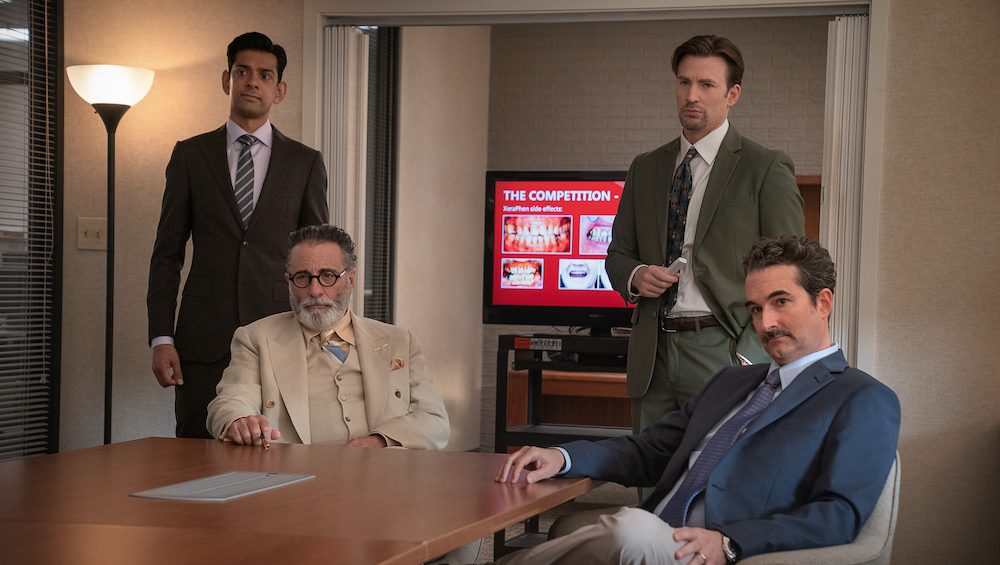Netflix’s ‘Pain Hustlers’ is a story of sheer greed and how it can lead people to justify their means and ends without caring about the consequences of their actions. The story focuses on a company named Zanna Therapeutics, whose owner and top executives do everything in their power to push for the sale of a drug called Lonafen. At first, they delude themselves into believing that they are doing this to get it to the people who actually need it. But soon, they become absorbed in their insatiable desire for money, which eventually costs them everything. In this article, we take a look at the real company and the real drug that inspired the fictional Zanna and Lonafen in the Emily Blunt starrer movie. SPOILERS AHEAD
The True Inspiration Behind Zanna Therapeutics and Lonafen
‘Pain Hustlers’ is loosely based on the events surrounding the rise and fall of a pharmaceutical company called Insys Therapeutics. Zanna is a stand-in for it, and Lonafen is a representation of Insys’s fentanyl-containing drug called Subsys. Andy Garcia’s character, Jack Neel, is inspired by John Kapoor, who created Insys and fought hard to bring Subsys into the market.

The movie picks up at the point where Lonafen has been around for a while but is not generating enough sales to keep the company afloat. Neel and his circle of executives are lost on how to improve sales so they can stop their ship from sinking. In real life, too, after Subsys was brought on the market, it didn’t perform as well as Kapoor had thought it would. But he was dedicated to the idea of making it work, even if it meant taking some illegal routes.
Like Lonafen, Subsys is a spray that is said to be speedier in showing effects as compared to its counterparts in the market. It is intended to treat “breakthrough cancer pain that is not controlled by other medicines.” After starting clinical trials in 2007, the drug received a seal of approval in 2012. Due to its specific use, Subsys is quite a pricey drug, with its one unit of 100mcg available in the range of around $70-$80, making it a lucrative asset for the company.
To increase the sales of the drug, Insys is said to have used every trick in its book. From hiring young and attractive people as sales reps to targeting specific doctors, Insys did what most other pharma companies did, too. But it took things a bit far when it launched its “speakers program,” which was basically a way to bribe doctors into prescribing Subsys to their patients. Initially, its sale was limited to cancer patients, but then, they, allegedly, pushed for selling it to people outside of that category and suffering from mild to chronic pain due other other issues. The film picks all these details and presents them in a fictional light to show the impact that this string of decisions by the company’s executives had on the lives of the common people.
How Things Ended For Insys Therapeutics
While the sale of Subsys changed everything for Insys’ owner and his employees, things were bound to end as the company turned more and more toward shadier practices. Several whistleblowers made it possible for the prosecution to build a case against John Kapoor, who was sentenced to 66 months in prison, which is in stark contrast to the 15 years recommended by the government. He was also “ordered to pay forfeiture and restitution.”

Kapoor was found guilty of “orchestrating a scheme to bribe practitioners to prescribe Subsys.” Seven other Insys executives and employees were found guilty of their involvement in the racketeering schemes for the sale of the drug, which included bribing the doctors. In 2020, the former CEO, Michael Babich, was sentenced to thirty months, and former VP of sales, Alec Burlakoff, received twenty-six months in prison.
In 2019, Insys Therapeutics filed for Chapter 11 bankruptcy protection. This was after the company had agreed to pay $225 million “to settle the government’s separate criminal and civil investigations.” As for Subsys, it was sold to Wyoming-based BTcP Pharma LLC, which got around $20 million in royalties for Insys. This move received objection from state attorney generals, who believed that this could further result in the abuse of the drugs. While BTcP assured that they would only market Subsys for cancer patients, as was originally intended, it was reportedly argued that the new company had “ample red flags” to create debt.
According to the objection statement: “Patients became addicted to Subsys through Insys’ misconduct, and their addiction has not been treated; the court should ensure, in approving any sale, that Subsys will not fall into the hands of those who would further exploit that addiction through intentional conduct or negligence. Further harm should not emerge from this bankruptcy.” The drug continues to be sold, but hopefully, the sellers are doing a better job of curtailing the problems created by those previously in charge of it.
Read More: Is Liza Drake Based on a Real Person?


You must be logged in to post a comment.